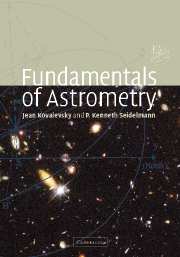Book contents
- Frontmatter
- Contents
- Preface
- List of abbreviations
- 1 Introduction
- 2 New observational techniques
- 3 Basic principles and coordinate systems
- 4 Treatment of astronomical data
- 5 Principles of relativity
- 6 Apparent displacements of celestial objects
- 7 Extragalactic reference frame
- 8 Dynamical reference frame
- 9 Terrestrial coordinate systems
- 10 Earth orientation
- 11 Stars
- 12 Double and multiple star systems
- 13 Astronomical phenomena
- 14 Applications to observations
- Appendix A Examples
- Appendix B Astronomical values
- Glossary
- References
- Index
1 - Introduction
Published online by Cambridge University Press: 05 November 2011
- Frontmatter
- Contents
- Preface
- List of abbreviations
- 1 Introduction
- 2 New observational techniques
- 3 Basic principles and coordinate systems
- 4 Treatment of astronomical data
- 5 Principles of relativity
- 6 Apparent displacements of celestial objects
- 7 Extragalactic reference frame
- 8 Dynamical reference frame
- 9 Terrestrial coordinate systems
- 10 Earth orientation
- 11 Stars
- 12 Double and multiple star systems
- 13 Astronomical phenomena
- 14 Applications to observations
- Appendix A Examples
- Appendix B Astronomical values
- Glossary
- References
- Index
Summary
Astrometry is positional astronomy. It encompasses all that is necessary to provide the positions and motions of celestial bodies. This includes observational techniques, instrumentation, processing and analysis of observational data, positions and motions of the bodies, reference frames, and the resulting astronomical phenomena.
The practical side of astrometry is complemented by a number of theoretical aspects, which relate the observations to laws of physics and to the distribution of matter, or celestial bodies, in space. Among the most important are celestial mechanics, optics, theory of time and space references (particularly with regards to general relativity), astrophysics, and statistical inference theory. These scientific domains all contribute to the reduction procedures which transform the observed raw data acquired by the instruments into quantities that are useable for the physical interpretation of the observed phenomena. The goals of this book are to present the theoretical bases of astrometry and the main features of the reduction procedures, as well as to give examples of their application.
Astrometry is fundamental to, and the basis for, all other fields of astronomy. At minimal accuracy levels the pointing of telescopes depends on astrometry. The cycle of days, the calendar, religious cycles and holidays are based on astrometry. Navigation and guidance systems are based on astrometry, previously for nautical purposes and now primarily for space navigation.
Astronomy and astrophysics are also strongly dependent on astrometry.
- Type
- Chapter
- Information
- Fundamentals of Astrometry , pp. 1 - 10Publisher: Cambridge University PressPrint publication year: 2004



